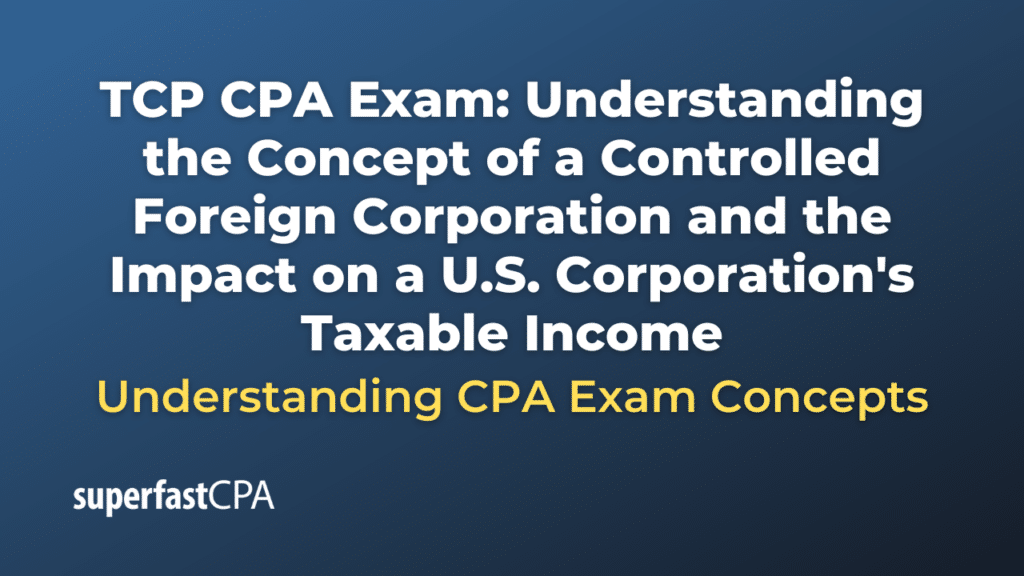Introduction
The Globalization of Business Operations and Taxation
In this article, we’ll cover understanding the concept of a controlled foreign corporation and the impact on a U.S. corporation’s taxable income. In today’s interconnected world, corporations of all sizes operate on a global scale, engaging in business activities across multiple jurisdictions. This globalization presents numerous opportunities for companies to expand their markets, increase revenues, and leverage cost efficiencies in foreign countries. However, with these opportunities comes the complexity of navigating various tax regimes. Corporations must manage not only the tax laws of their home country but also those of the countries in which they conduct business.
For U.S. corporations, one of the critical challenges is understanding how foreign income is taxed under U.S. law. This brings into play complex rules designed to prevent the avoidance of U.S. tax through the use of foreign subsidiaries. One of the most significant frameworks governing the taxation of foreign income is the Controlled Foreign Corporation (CFC) regime.
What is a Controlled Foreign Corporation (CFC)?
A Controlled Foreign Corporation, or CFC, is a foreign corporation in which U.S. shareholders—specifically those owning 10% or more of the corporation’s voting stock or value—collectively own more than 50% of the total stock. This threshold is crucial because once a foreign entity is classified as a CFC, U.S. tax law imposes specific rules to ensure that income earned by the foreign subsidiary is subject to taxation by the U.S. government, even if those earnings are not repatriated.
CFC rules were introduced to prevent U.S. taxpayers from deferring taxes by accumulating income in foreign entities located in low- or no-tax jurisdictions. Through this mechanism, certain types of foreign income must be included in the U.S. shareholders’ income, even if the profits remain offshore.
Importance of CFCs for U.S. Corporations with Foreign Subsidiaries
For U.S. corporations with foreign subsidiaries, the concept of a CFC is critical because it dictates how and when foreign income becomes taxable in the United States. Before the CFC rules, U.S. corporations could defer U.S. taxes on foreign profits by simply leaving the profits in foreign subsidiaries, only paying U.S. taxes when the earnings were repatriated through dividends. The CFC regime disrupts this deferral by requiring certain types of income, such as passive income, to be taxed currently, regardless of whether it is repatriated.
Understanding CFCs is essential for U.S. corporations operating internationally, as it affects strategic decisions about foreign operations, including structuring, financing, and profit repatriation.
Relevance of CFCs for the TCP CPA Exam
The TCP CPA exam, which focuses on taxation, accounting, and auditing standards for global businesses, places significant emphasis on the taxation of foreign income. The rules surrounding Controlled Foreign Corporations are a fundamental component of this domain, making them crucial for CPA candidates to grasp. The exam tests knowledge of how CFCs impact a U.S. corporation’s taxable income, requiring candidates to understand not only the definitions but also the complex tax rules, including Subpart F income and the Global Intangible Low-Taxed Income (GILTI) provisions.
As U.S. corporations continue to expand their global footprints, the ability to navigate international tax laws, including CFC regulations, has become a vital skill for tax professionals. Understanding these rules is not only essential for passing the TCP CPA exam but also for effective tax planning and compliance in the real world.
Definition of a Controlled Foreign Corporation (CFC)
Controlled Foreign Corporation (CFC) Under U.S. Tax Law
A Controlled Foreign Corporation (CFC) is a key concept in U.S. international tax law, designed to limit tax deferral strategies used by U.S. corporations with foreign subsidiaries. The legal definition of a CFC is outlined in Section 957 of the U.S. Internal Revenue Code (IRC). According to the IRC, a CFC is any foreign corporation in which “U.S. shareholders” collectively own more than 50% of the total combined voting power of all classes of stock entitled to vote or the total value of the company’s stock.
This designation is crucial because, once a foreign corporation meets the criteria of a CFC, specific U.S. tax rules come into effect. These rules prevent U.S. shareholders from deferring taxes on certain types of income earned by the foreign corporation, even if those earnings are not repatriated to the United States.
The “U.S. Shareholders” Concept
To understand the definition of a CFC, it’s essential to first grasp the concept of a “U.S. shareholder.” For purposes of determining whether a foreign corporation qualifies as a CFC, a U.S. shareholder is any U.S. person who owns, directly, indirectly, or constructively, 10% or more of the total combined voting power of all classes of stock in the foreign corporation or 10% or more of the total value of the stock of such corporation.
U.S. persons can include individuals, corporations, partnerships, trusts, and estates. This broad definition ensures that a wide range of U.S. investors with significant influence over a foreign corporation are subject to U.S. tax rules designed to limit tax avoidance through foreign entities.
Ownership Threshold for CFC Status
A foreign corporation is classified as a CFC when more than 50% of the corporation’s stock (measured by either voting power or total value) is owned by U.S. shareholders. This means that if U.S. shareholders collectively own more than half of the voting stock or more than half of the value of all stock in the foreign corporation, that corporation becomes a CFC.
The ownership rules for determining CFC status include both direct and indirect ownership. For example, a U.S. shareholder can be deemed to own stock in a foreign corporation even if their ownership is through another entity, such as a partnership or trust. Additionally, the concept of constructive ownership comes into play, where stock owned by related parties, such as family members or controlled corporations, may be attributed to a U.S. shareholder for purposes of calculating the ownership percentage.
Once a foreign corporation is classified as a CFC, U.S. tax laws—specifically, the Subpart F income rules and the Global Intangible Low-Taxed Income (GILTI) provisions—apply. These rules impose current U.S. taxation on certain types of income earned by the CFC, preventing the deferral of U.S. tax on foreign earnings that would otherwise only be taxed when repatriated. Understanding this ownership threshold is essential for recognizing when a foreign corporation falls under the U.S. CFC regime, triggering specific tax reporting and compliance obligations.
U.S. Tax Rules for CFCs
Subpart F Income
Definition and Key Elements
Subpart F income refers to specific types of foreign income earned by a Controlled Foreign Corporation (CFC) that U.S. tax law requires to be included in the taxable income of U.S. shareholders, regardless of whether the income is actually distributed. The primary purpose of Subpart F is to prevent U.S. corporations from deferring U.S. tax on passive or easily moveable income by holding it in foreign subsidiaries located in low-tax jurisdictions.
Under the Subpart F rules, U.S. shareholders of a CFC must include their share of the CFC’s Subpart F income on their U.S. tax returns, even if the CFC does not distribute this income as a dividend. This anti-deferral rule ensures that U.S. corporations pay current U.S. taxes on certain types of income earned by their foreign subsidiaries, thus limiting the potential for indefinite tax deferral.
The Concept of Passive Income as Subpart F Income
A key category of Subpart F income is passive income, which generally includes income that is not derived from active business operations. The rationale behind taxing passive income under Subpart F is that it is relatively easy for companies to shift this type of income to low-tax jurisdictions for tax avoidance purposes. Passive income subject to Subpart F includes:
- Interest: Income earned from lending money or holding debt instruments.
- Dividends: Income received from owning shares in other companies.
- Royalties: Payments for the use of intellectual property, such as patents, trademarks, or copyrights.
- Rents: Income from leasing real estate or other property.
In addition to passive income, certain types of active income that are deemed to be easily moveable, such as income from services provided by a CFC to related parties, may also be classified as Subpart F income.
General Categories of Subpart F Income and the Goal of Anti-Deferral Rules
Subpart F income encompasses various categories of income that the U.S. government views as susceptible to tax avoidance. The most common categories include:
- Foreign Personal Holding Company Income (FPHCI): This primarily includes passive income, such as interest, dividends, royalties, and rents, as discussed above.
- Foreign Base Company Sales Income (FBCSI): Income derived from the sale of personal property to or from related parties, where the goods are produced and sold outside the CFC’s country of incorporation.
- Foreign Base Company Services Income (FBC Services Income): Income earned by a CFC from providing services to or for related parties outside the CFC’s home country.
- Insurance Income: Certain types of income earned by a CFC engaged in the insurance business that relate to foreign risks or U.S. risks insured outside the U.S.
The primary goal of Subpart F rules is to curb the deferral of U.S. taxes on income that can be easily shifted to low-tax jurisdictions. By taxing certain categories of income immediately, the U.S. government ensures that this income is not indefinitely sheltered from U.S. tax obligations.
Example Calculations of Subpart F Income Inclusion
Let’s consider an example to illustrate how Subpart F income is calculated and included in a U.S. shareholder’s taxable income.
Example:
ABC Corp is a CFC owned by U.S. shareholders. During the year, ABC Corp earns $100,000 in foreign personal holding company income (interest and dividends). Under Subpart F, this income is subject to immediate U.S. taxation, even if it is not distributed to the U.S. shareholders.
- Total Subpart F income = $100,000
- Each U.S. shareholder must include their pro-rata share of this $100,000 in their taxable income, based on their ownership percentage.
For example, if a U.S. shareholder owns 40% of ABC Corp, they would include $40,000 (40% of $100,000) of Subpart F income in their U.S. taxable income for the year. This inclusion occurs even though the shareholder has not received an actual cash distribution from the CFC.
This immediate inclusion ensures that the passive income earned by the foreign subsidiary is subject to current U.S. tax, preventing indefinite deferral through offshore earnings.
Global Intangible Low-Taxed Income (GILTI)
Introduction to GILTI as a Way to Tax Foreign Low-Taxed Earnings of a CFC
Global Intangible Low-Taxed Income (GILTI) is a provision introduced by the Tax Cuts and Jobs Act of 2017 (TCJA) as part of the U.S. government’s efforts to prevent multinational corporations from shifting profits to low-tax jurisdictions. GILTI aims to tax the foreign income of Controlled Foreign Corporations (CFCs) that exceeds a deemed return on tangible assets, targeting income generated from intangible assets like intellectual property, which can easily be shifted across borders to minimize taxes.
GILTI is calculated on an aggregate basis for all of a U.S. corporation’s CFCs and requires the inclusion of certain foreign income in the U.S. corporation’s taxable income, even if the income is not repatriated to the U.S. The intention is to prevent U.S. corporations from deferring U.S. taxes on their foreign earnings and to ensure that a minimum level of tax is paid on these profits.
Calculation of GILTI: Inclusion Percentage, Deduction Allowed, and Foreign Tax Credits
The calculation of GILTI involves several steps and components, which are designed to capture the CFC’s low-taxed income and determine how much of it should be taxed in the U.S. Here’s a breakdown of the key components of the GILTI calculation:
- Net Tested Income: This is the total income of all the CFCs owned by a U.S. shareholder, excluding certain items such as Subpart F income, effectively connected income (ECI), and income subject to high foreign taxes. The remaining income is considered “tested income.”
- Net Deemed Tangible Income Return (NDTIR): The U.S. tax code allows a 10% return on a CFC’s Qualified Business Asset Investment (QBAI), which generally includes the tangible assets held by the CFC (e.g., property, plant, and equipment). This 10% return is deducted from the tested income.
- GILTI Inclusion: The U.S. shareholder’s GILTI inclusion is the excess of net tested income over the net deemed tangible income return (i.e., the portion of the CFC’s income that exceeds the allowed return on tangible assets).
The formula for calculating GILTI is:
GILTI = Net Tested Income – (10% x QBAI) - GILTI Deduction: U.S. corporate taxpayers are allowed a 50% deduction on their GILTI inclusion under IRC Section 250. This deduction effectively reduces the GILTI income subject to tax to half of the calculated GILTI amount.
- Foreign Tax Credits (FTC): U.S. taxpayers can claim a foreign tax credit for up to 80% of the foreign taxes paid on GILTI income. However, GILTI-related foreign tax credits are subject to certain limitations and cannot be carried forward or back.
Example Calculations of GILTI and Its Impact on a U.S. Corporation’s Taxable Income
Example:
XYZ Corporation, a U.S. company, owns a CFC that has $500,000 in tested income for the year. The CFC’s Qualified Business Asset Investment (QBAI) is $1,000,000. The CFC paid $50,000 in foreign taxes on its earnings.
- Step 1: Calculate the Net Deemed Tangible Income Return (NDTIR)
- NDTIR = 10% of QBAI = 10% of $1,000,000 = $100,000
- Step 2: Calculate GILTI
- GILTI = Net Tested Income – NDTIR
- GILTI = $500,000 – $100,000 = $400,000
- Step 3: Apply the GILTI Deduction
- Deduction = 50% of GILTI = 50% of $400,000 = $200,000
- GILTI subject to U.S. tax = $400,000 – $200,000 = $200,000
- Step 4: Calculate U.S. Tax on GILTI
- U.S. tax rate = 21%
- U.S. tax on GILTI = 21% of $200,000 = $42,000
- Step 5: Apply Foreign Tax Credits
- Foreign taxes paid = $50,000
- FTC allowed for GILTI = 80% of foreign taxes paid = 80% of $50,000 = $40,000
- Step 6: Final U.S. Tax Liability
- U.S. tax liability after FTC = $42,000 – $40,000 = $2,000
Impact on XYZ Corporation’s Taxable Income:
As shown in the example, XYZ Corporation’s GILTI inclusion results in $400,000 of foreign earnings being subject to U.S. tax. However, after the 50% GILTI deduction and the use of foreign tax credits, XYZ’s final U.S. tax liability on its GILTI is reduced to just $2,000. This demonstrates how the GILTI provision imposes U.S. tax on foreign earnings while allowing some relief through deductions and credits.
This system ensures that U.S. corporations pay a minimum level of tax on their foreign profits, even if they have structured operations in low-tax jurisdictions. Understanding the GILTI provisions is essential for TCP CPA exam candidates and tax professionals working with multinational corporations.
Impact of CFCs on a U.S. Corporation’s Taxable Income
Inclusion of Subpart F Income and GILTI
How Subpart F Income and GILTI Are Reported on U.S. Tax Returns
When a U.S. corporation owns a Controlled Foreign Corporation (CFC), specific income categories, such as Subpart F income and Global Intangible Low-Taxed Income (GILTI), must be included in the corporation’s U.S. taxable income, even if the CFC does not distribute these earnings. To ensure compliance with these rules, U.S. corporations are required to file various forms and schedules with the Internal Revenue Service (IRS).
- Form 5471: This is the primary form used to report a U.S. shareholder’s ownership in a CFC. It includes detailed information about the foreign corporation’s income, assets, and shareholder information. Within Form 5471, the key schedules for reporting Subpart F income and GILTI are:
- Schedule I: U.S. Shareholder’s Information for Global Intangible Low-Taxed Income (GILTI) and Subpart F Income. This schedule captures the U.S. shareholder’s share of the CFC’s Subpart F income and GILTI, which must be included in the U.S. corporation’s taxable income.
- Schedule P: This schedule specifically deals with GILTI calculations. It includes the breakdown of GILTI, the deductions allowed, and the corresponding foreign tax credits.
These schedules are crucial for ensuring that the U.S. corporation properly reports its foreign income and complies with the anti-deferral rules applicable to CFCs.
Timing of Inclusion and How It Affects Taxable Income
The inclusion of Subpart F income and GILTI in a U.S. corporation’s taxable income is required in the year in which the income is earned by the CFC, regardless of whether that income has been distributed to the U.S. shareholder. This “current inclusion” rule prevents U.S. taxpayers from deferring U.S. tax on foreign earnings by keeping them offshore.
- Subpart F Income: This income must be included in the U.S. corporation’s taxable income in the same year it is earned by the CFC. For example, if a CFC earns Subpart F income in 2024, the U.S. shareholder must report their share of this income on their 2024 U.S. tax return.
- GILTI: Similar to Subpart F income, GILTI is included in the U.S. corporation’s taxable income in the year it is earned by the CFC. GILTI inclusion occurs on an aggregate basis across all CFCs owned by the U.S. shareholder, and the resulting GILTI amount is reported on the U.S. tax return for the same tax year.
The timing of these inclusions can significantly affect a U.S. corporation’s taxable income, as both Subpart F income and GILTI can lead to immediate U.S. tax liabilities, even if no actual cash distributions have been made by the CFC. This can create cash flow challenges for U.S. corporations, which may need to pay taxes on foreign earnings that have not yet been repatriated.
Example Scenarios Demonstrating the Tax Impact on a U.S. Corporation’s Income
Scenario 1: Subpart F Income Inclusion
ABC Corp, a U.S. corporation, owns a CFC that earns $200,000 in passive income (interest and dividends), which qualifies as Subpart F income. ABC Corp owns 60% of the CFC, making its share of the Subpart F income $120,000.
- Reporting: ABC Corp must include the $120,000 of Subpart F income on its U.S. tax return for the year in which the income was earned by the CFC, even if no dividend was paid by the CFC.
- Tax Impact: Assuming ABC Corp is subject to a 21% U.S. corporate tax rate, its U.S. tax liability on the $120,000 of Subpart F income will be $25,200 ($120,000 × 21%).
Scenario 2: GILTI Inclusion
XYZ Corp, another U.S. company, owns 100% of a CFC. The CFC earns $500,000 in tested income, and its Qualified Business Asset Investment (QBAI) is $1,000,000. Using the GILTI formula, XYZ Corp determines that its GILTI inclusion is $400,000 (after deducting the deemed tangible income return of $100,000).
- Reporting: XYZ Corp must include the $400,000 of GILTI on its U.S. tax return, even if the CFC has not repatriated these earnings.
- GILTI Deduction: XYZ Corp is allowed a 50% deduction on the GILTI amount, reducing the taxable GILTI to $200,000.
- Foreign Tax Credit: If the CFC paid $50,000 in foreign taxes, XYZ Corp can claim a foreign tax credit of $40,000 (80% of $50,000).
- Tax Impact: After applying the foreign tax credit and the GILTI deduction, XYZ Corp’s U.S. tax liability on the GILTI inclusion is as follows:
- U.S. tax on GILTI: $42,000 (21% of $200,000)
- Foreign tax credit: $40,000
- Final U.S. tax liability: $42,000 – $40,000 = $2,000
In both scenarios, the U.S. corporation is required to report and pay U.S. taxes on income earned by the CFC, whether through Subpart F income or GILTI. The key takeaway is that these inclusions result in current U.S. tax liabilities, even if the foreign earnings have not yet been distributed as dividends, making it crucial for U.S. corporations to plan their cash flow and tax strategies accordingly.
Foreign Tax Credits (FTC) and Interaction with CFC Rules
Explanation of the Foreign Tax Credit System
The Foreign Tax Credit (FTC) is a mechanism that allows U.S. corporations to reduce their U.S. tax liability by taking a credit for taxes paid to foreign governments on income earned abroad. The goal of the FTC is to prevent double taxation, where the same income is taxed by both the U.S. and the foreign country in which it was earned. By applying the FTC, U.S. taxpayers can offset some or all of the U.S. tax that would otherwise be due on foreign-sourced income.
The FTC operates by allowing a dollar-for-dollar reduction of U.S. taxes owed, but it is limited to the amount of U.S. tax attributable to foreign-source income. This limit ensures that foreign taxes do not reduce the U.S. tax liability below the amount that would have been due if the income were earned in the U.S. The FTC can be applied to various types of foreign income, including income subject to the Controlled Foreign Corporation (CFC) rules, such as Subpart F income and Global Intangible Low-Taxed Income (GILTI).
Interaction of Foreign Tax Credits with Subpart F and GILTI Inclusions
When a U.S. corporation includes Subpart F income or GILTI in its taxable income, it may also be eligible to claim an FTC for foreign taxes paid by the CFC on that income. However, the rules for applying the FTC differ slightly for Subpart F income and GILTI.
- Subpart F Income:
Subpart F income is generally treated as regular foreign-sourced income, and any foreign taxes paid by the CFC on this income can be credited against the U.S. corporation’s tax liability. The FTC for Subpart F income can be applied to offset the full amount of U.S. tax due on the foreign income. - GILTI:
The FTC for GILTI is subject to certain limitations. For GILTI, U.S. corporations can only claim an FTC for up to 80% of the foreign taxes paid on the GILTI amount. Additionally, GILTI-related FTCs are placed in a separate “basket” from other foreign-sourced income and cannot be carried forward or backward to offset U.S. taxes in other years. This limits the ability to fully offset U.S. tax liabilities on GILTI with foreign tax credits, ensuring that some U.S. tax is paid on low-taxed foreign income.
Example Calculations Showing How FTCs Can Offset U.S. Taxes on CFC Income
Example 1: FTC for Subpart F Income
ABC Corp, a U.S. corporation, owns 100% of a CFC that earns $100,000 in passive income (classified as Subpart F income). The CFC pays $25,000 in foreign taxes on this income. ABC Corp is required to include the $100,000 of Subpart F income in its U.S. taxable income.
- Step 1: Calculate U.S. Tax on Subpart F Income
U.S. corporate tax rate = 21%
U.S. tax on Subpart F income = $100,000 × 21% = $21,000 - Step 2: Apply Foreign Tax Credit
Since the foreign taxes paid ($25,000) exceed the U.S. tax liability on the Subpart F income ($21,000), ABC Corp can fully offset its U.S. tax liability with the FTC.- U.S. tax liability after FTC = $21,000 – $21,000 = $0
In this case, the foreign tax credit completely eliminates ABC Corp’s U.S. tax liability on the Subpart F income because the foreign taxes paid exceed the U.S. taxes due.
Example 2: FTC for GILTI
XYZ Corp, another U.S. company, owns a CFC that earns $400,000 in GILTI. The CFC pays $50,000 in foreign taxes on this income. XYZ Corp must include the $400,000 of GILTI in its U.S. taxable income, but it is eligible for a 50% deduction under the GILTI rules.
- Step 1: Calculate U.S. Taxable GILTI
GILTI inclusion = $400,000
GILTI deduction = 50% of $400,000 = $200,000
Taxable GILTI = $400,000 – $200,000 = $200,000 - Step 2: Calculate U.S. Tax on GILTI
U.S. corporate tax rate = 21%
U.S. tax on GILTI = $200,000 × 21% = $42,000 - Step 3: Apply Foreign Tax Credit for GILTI
Under the GILTI rules, XYZ Corp can only claim a credit for 80% of the foreign taxes paid on the GILTI income.
Foreign taxes paid = $50,000
FTC allowed for GILTI = 80% of $50,000 = $40,000 - Step 4: Final U.S. Tax Liability
U.S. tax liability after applying the FTC = $42,000 – $40,000 = $2,000
In this example, the foreign tax credit reduces XYZ Corp’s U.S. tax liability on GILTI from $42,000 to $2,000, demonstrating how FTCs can substantially offset U.S. taxes on foreign income, though a portion of U.S. tax on GILTI still remains due to the 80% limitation on the FTC.
These examples highlight the importance of foreign tax credits in mitigating the impact of Subpart F income and GILTI on a U.S. corporation’s taxable income. While the FTC helps reduce double taxation, the limitations on GILTI-related FTCs ensure that some level of U.S. tax is still paid on low-taxed foreign earnings.
Planning Considerations for U.S. Corporations with CFCs
Foreign Earnings Deferral and Repatriation Strategies
Deferral of Foreign Earnings Before the Introduction of Subpart F and GILTI
Before the introduction of the Subpart F income rules in 1962 and the Global Intangible Low-Taxed Income (GILTI) provisions in 2017, U.S. corporations with Controlled Foreign Corporations (CFCs) were able to defer U.S. taxation on foreign earnings indefinitely. Under the deferral strategy, U.S. taxes on foreign profits were only imposed when those earnings were repatriated to the U.S. parent company in the form of dividends or other distributions. As a result, corporations could accumulate profits offshore in low-tax jurisdictions, avoiding immediate U.S. tax and delaying any tax liability until the income was brought back to the U.S.
This deferral strategy encouraged U.S. corporations to keep their profits in foreign subsidiaries, particularly in countries with low or zero corporate tax rates. By deferring U.S. taxes, companies could reinvest those untaxed foreign earnings into global operations, gaining a competitive advantage through reduced effective tax rates.
However, the introduction of Subpart F significantly changed the landscape for U.S. corporations with CFCs. Subpart F requires certain types of foreign income—particularly passive income such as interest, dividends, royalties, and rents—to be included in U.S. taxable income in the year it is earned by the CFC, thereby curtailing the indefinite deferral of taxes on these types of earnings. GILTI further expanded these anti-deferral rules by taxing a broader range of foreign earnings, particularly low-taxed income derived from intangible assets.
Repatriation of Earnings and Tax Consequences
While deferral strategies allowed corporations to avoid U.S. taxation on foreign profits for extended periods, eventually, companies needed to repatriate these earnings to the U.S. parent. Prior to the Tax Cuts and Jobs Act (TCJA) of 2017, repatriation typically involved significant tax consequences. U.S. corporations faced U.S. corporate income tax rates (as high as 35%) on repatriated earnings, which often discouraged bringing profits back into the U.S. economy.
The TCJA introduced a one-time “transition tax” on previously untaxed foreign earnings as part of the shift toward a more territorial tax system. Under the transition tax rules, U.S. corporations were required to pay tax on accumulated foreign earnings held offshore as of December 31, 2017, regardless of whether those earnings were repatriated. The tax rates for this one-time levy were 15.5% for earnings held in cash or cash equivalents and 8% for earnings invested in illiquid assets. This transition tax marked the end of indefinite deferral for pre-2018 earnings.
Following the transition tax, the TCJA also introduced the participation exemption, which allows U.S. corporations to exclude dividends received from foreign subsidiaries from taxable income, provided the U.S. parent owns at least 10% of the foreign subsidiary. This participation exemption is part of the broader shift to a quasi-territorial tax system, under which foreign earnings can be repatriated to the U.S. tax-free, provided they meet certain conditions.
Planning Considerations for Repatriation:
- Tax-Free Repatriation: Under the TCJA’s participation exemption, U.S. corporations can now repatriate earnings tax-free, making it more attractive for companies to bring profits back to the U.S. and use them for domestic investments, share buybacks, or dividend distributions.
- Foreign Tax Credits (FTCs): Companies must still consider the use of foreign tax credits when repatriating earnings to ensure that they are not subject to double taxation in both the U.S. and the foreign country.
- Impact of Subpart F and GILTI: Even with the participation exemption, certain foreign earnings, particularly those subject to Subpart F or GILTI, will be taxed in the U.S. as they are earned by the CFC, reducing the need to focus solely on repatriation strategies.
While deferral strategies allowed U.S. corporations to accumulate foreign profits without immediate U.S. tax liability before the introduction of Subpart F and GILTI, modern tax rules focus on taxing certain foreign earnings on a current basis. With the TCJA’s participation exemption, corporations can now repatriate post-2017 earnings without additional U.S. taxes, making it essential for corporations to evaluate their foreign earnings strategies in light of the new tax landscape.
Tax Minimization Strategies
Tax-Efficient Structuring to Minimize Subpart F or GILTI Exposure
U.S. corporations with Controlled Foreign Corporations (CFCs) must navigate complex tax rules, such as Subpart F and Global Intangible Low-Taxed Income (GILTI), which are designed to prevent tax avoidance through the deferral of foreign earnings. To minimize the exposure to these provisions, corporations can adopt tax-efficient structuring strategies that reduce the amount of income subject to immediate U.S. taxation.
- Restructuring Business Operations:
U.S. corporations can review and adjust how their CFCs operate and generate income to avoid triggering Subpart F or GILTI inclusions. For example:- Avoidance of Passive Income: Subpart F targets passive income (such as interest, dividends, rents, and royalties), which is more easily shifted to low-tax jurisdictions. Companies can structure their CFCs to focus on generating active business income rather than passive income, which reduces exposure to Subpart F inclusions.
- Transfer Pricing Adjustments: U.S. corporations can review and adjust transfer pricing arrangements to ensure that pricing for goods, services, or intellectual property between related parties is in line with the arm’s length standard. By properly allocating income based on business operations, companies can reduce the risk of generating income that qualifies as Subpart F or GILTI.
- Use of Hybrid Entities or Instruments:
Hybrid entities or financial instruments that are treated differently for tax purposes in different jurisdictions can be used to minimize Subpart F or GILTI exposure. For example, a hybrid entity may be classified as a corporation in one jurisdiction but treated as a partnership in another. Proper structuring of these entities can allow for the deferral of U.S. taxes while maintaining tax-efficient foreign operations. - Maximizing the Deemed Tangible Income Return (DTIR):
GILTI only taxes foreign earnings that exceed a deemed 10% return on a CFC’s tangible assets, known as Qualified Business Asset Investment (QBAI). U.S. corporations can invest in tangible assets, such as property, plant, and equipment, within their CFCs to increase their QBAI and reduce the amount of income subject to GILTI. This strategy lowers the GILTI inclusion by ensuring that a larger portion of foreign earnings qualifies for the DTIR exemption. - Holding Intellectual Property in High-Tax Jurisdictions:
Since GILTI targets income from intangible assets, U.S. corporations may consider holding their intellectual property (IP) in jurisdictions with higher tax rates. By doing so, the foreign taxes paid on GILTI income will be higher, allowing the U.S. corporation to claim a more substantial foreign tax credit (FTC). This strategy can mitigate the tax impact of GILTI inclusions.
Use of Foreign Tax Planning to Optimize the Use of Foreign Tax Credits
Foreign tax credits (FTCs) are a crucial tool for U.S. corporations to avoid double taxation on income earned through their CFCs. Careful planning is required to optimize the use of FTCs, particularly in the context of Subpart F and GILTI income.
- Maximizing FTC Utilization:
U.S. corporations can plan to ensure that the foreign taxes paid by their CFCs are eligible for the foreign tax credit. This includes:- Careful Structuring of Foreign Income: Ensuring that foreign income is taxed at rates high enough to generate FTCs that can offset U.S. taxes but not so high that foreign taxes are excessive.
- Use of the GILTI FTC Basket: GILTI income is subject to an FTC limitation, allowing only 80% of foreign taxes to be credited. Planning to maximize the taxes paid in high-tax jurisdictions or strategically managing income across jurisdictions can help optimize the 80% FTC limitation.
- Timing of Foreign Tax Payments:
Planning the timing of foreign tax payments can be essential in matching foreign tax credits with the U.S. taxes on Subpart F or GILTI income. By ensuring that foreign taxes are paid in the same year that the income is included in U.S. taxable income, corporations can avoid mismatches that might result in FTCs not being fully utilized. - Managing the FTC Limitation:
The foreign tax credit is subject to a limitation based on the U.S. corporation’s foreign-source income. Companies can use income shifting strategies to increase the amount of foreign-source income in high-tax jurisdictions, thereby increasing the allowable FTC. This can include allocating more expenses to domestic operations and reducing foreign-source expenses to boost foreign taxable income and enhance the FTC limit. - Carryforward and Carryback Options:
If a corporation cannot use all of its FTCs in the current tax year, it can carry them forward for up to 10 years or back one year. Planning to use these credits in years where foreign-source income or U.S. tax liability is higher can help ensure that the corporation maximizes the benefit of its FTCs. This requires tracking foreign taxes paid and ensuring compliance with carryforward and carryback rules. - Avoiding FTC Traps:
U.S. corporations should be cautious of tax planning strategies that inadvertently disqualify certain foreign taxes from FTC eligibility. For instance, certain hybrid arrangements or transactions that result in foreign taxes not being recognized under U.S. law can reduce the ability to claim an FTC. Careful planning is needed to ensure that all foreign taxes remain creditable.
Effective tax planning can help U.S. corporations minimize the impact of Subpart F and GILTI inclusions, as well as optimize the use of foreign tax credits to reduce U.S. tax liabilities. These strategies, when properly implemented, can create a more tax-efficient structure for multinational operations.
Compliance and Reporting for CFCs
Form 5471 Reporting Requirements
Detailed Explanation of the Form, Who Needs to File, and the Information Required
Form 5471 is a critical reporting requirement for U.S. shareholders of a Controlled Foreign Corporation (CFC). It is used to report the U.S. taxpayer’s ownership interest in a foreign corporation, along with detailed information about the foreign entity’s financial and operational activities. Filing Form 5471 ensures compliance with U.S. tax laws governing foreign income and prevents the deferral of taxes on CFC earnings.
Who Needs to File:
Several categories of U.S. taxpayers are required to file Form 5471, depending on the level of ownership and control over the foreign corporation. These categories include:
- Category 1 Filers: U.S. shareholders of a foreign corporation that is treated as a CFC.
- Category 2 Filers: U.S. officers or directors of a foreign corporation if a U.S. person acquires at least 10% of the foreign corporation’s stock.
- Category 3 Filers: U.S. persons who acquire or dispose of stock in a foreign corporation, resulting in ownership of 10% or more of the stock.
- Category 4 Filers: U.S. persons who control a foreign corporation (generally owning more than 50% of the stock).
- Category 5 Filers: U.S. shareholders who own at least 10% of a CFC during any part of the year.
Information Required on Form 5471:
Form 5471 is comprehensive and requires a significant amount of information to be reported. The key sections include:
- Schedule C: The income statement of the foreign corporation, detailing the revenue, expenses, and net income.
- Schedule E: The balance sheet of the foreign corporation, providing an overview of the assets, liabilities, and equity.
- Schedule H: Information on the current earnings and profits (E&P) of the foreign corporation, which is relevant for determining the tax treatment of distributions and Subpart F income.
- Schedule I: U.S. shareholder’s inclusion of income under Subpart F and GILTI, detailing the amounts that must be included in U.S. taxable income.
- Schedule J: Accumulated earnings and profits of the foreign corporation, including those previously taxed by the U.S.
- Schedule M: Transactions between the foreign corporation and its U.S. shareholders or related parties, including loans, sales, and other transactions.
- Schedule P: GILTI-related income and deductions.
This form must be attached to the U.S. taxpayer’s annual tax return (Form 1040, 1120, or equivalent). Accurate and timely reporting of the required information ensures that U.S. shareholders remain in compliance with international tax laws, preventing potential penalties or audits.
Penalties for Non-Compliance and Common Errors in CFC Reporting
Failure to file Form 5471 or filing an incomplete or inaccurate form can lead to substantial penalties, making compliance essential for U.S. shareholders of foreign corporations. Key penalties for non-compliance include:
- Monetary Penalties:
- Failure to file Form 5471 results in a $10,000 penalty per form, per year.
- If the failure to file continues for more than 90 days after the IRS notifies the taxpayer, an additional penalty of $10,000 is imposed for each 30-day period of non-compliance, up to a maximum of $50,000 per form.
- Reduction in Foreign Tax Credits:
In cases where Form 5471 is not filed, the taxpayer may be subject to a reduction in their ability to claim foreign tax credits, which could increase their overall U.S. tax liability. - Criminal Penalties:
Willful failure to file Form 5471 can lead to criminal penalties, including fines and imprisonment.
Common Errors in CFC Reporting
Several common errors can occur when completing Form 5471, which could result in penalties or incorrect tax reporting. These include:
- Incorrect or Incomplete Ownership Information:
Failing to properly identify the ownership percentage or filing requirements based on different categories of filers can lead to incomplete filings. - Inaccurate Financial Information:
Errors in reporting the foreign corporation’s income statement, balance sheet, or earnings and profits (E&P) can result in the incorrect calculation of Subpart F or GILTI inclusions. This often stems from poor record-keeping or misunderstanding foreign accounting standards versus U.S. tax reporting rules. - Failure to Report Transactions with Related Parties:
Schedule M requires detailed reporting of transactions between the foreign corporation and its U.S. shareholders or related parties. Failing to properly document and report these transactions can result in missed inclusions of income or potential tax avoidance concerns. - Late Filing:
Missing the filing deadline for Form 5471, which is the same as the taxpayer’s annual return due date, can result in penalties, even if the form is filed soon after the deadline.
Form 5471 is an essential reporting requirement for U.S. shareholders of CFCs, and non-compliance can result in severe financial and legal penalties. Understanding the filing requirements, ensuring the accuracy of the information reported, and avoiding common errors are critical steps in managing international tax obligations effectively.
Compliance and Reporting for CFCs
Other Reporting Requirements
In addition to Form 5471, U.S. corporations with Controlled Foreign Corporations (CFCs) are subject to several other international tax reporting requirements, particularly when dealing with Global Intangible Low-Taxed Income (GILTI) and foreign tax credits (FTCs). These forms are crucial for accurately reporting foreign income and claiming tax reliefs such as FTCs to avoid double taxation.
Overview of Other International Tax Reporting Forms
- Form 8992 – U.S. Shareholder Calculation of GILTI Form 8992 is used by U.S. shareholders of a CFC to calculate and report their Global Intangible Low-Taxed Income (GILTI). GILTI is a key component of U.S. international tax law under the Tax Cuts and Jobs Act (TCJA), and it imposes current U.S. tax on certain foreign earnings of CFCs. Form 8992 requires U.S. shareholders to include the excess income of CFCs that exceeds a deemed return on their tangible assets.
- Key Information Required:
- The amount of tested income (total income of the CFC after subtracting certain deductions like Subpart F income).
- The CFC’s Qualified Business Asset Investment (QBAI), which is used to calculate the 10% deemed return on tangible assets.
- The GILTI inclusion amount: The total GILTI subject to U.S. tax after applying the QBAI deduction.
- Details of the deduction allowed for GILTI (50% deduction for corporations).
- Key Information Required:
- Form 1118 – Foreign Tax Credit for Corporations Form 1118 is used by U.S. corporations to claim the foreign tax credit (FTC) for taxes paid to foreign governments on income earned abroad. The purpose of the FTC is to prevent double taxation—ensuring that U.S. corporations are not taxed twice on the same income by both the U.S. and foreign jurisdictions.
- Key Information Required:
- Foreign taxes paid: U.S. corporations must provide details on the amount of taxes paid to each foreign country.
- Foreign-source income: Companies must report their foreign-source income in several categories (such as general income, passive income, GILTI income).
- FTC Limitation: The form includes calculations for the maximum foreign tax credit that can be claimed, which is limited to the U.S. tax liability on foreign-source income.
- Separate FTC Categories: Different categories of foreign income (e.g., GILTI, Subpart F, passive income) are tracked separately, and credits are applied differently to each category.
- Key Information Required:
- Form 8993 – Section 250 Deduction for Foreign-Derived Intangible Income (FDII) and GILTI Form 8993 is used to calculate the deduction allowed under IRC Section 250 for Foreign-Derived Intangible Income (FDII) and GILTI. For U.S. corporations, this form provides a deduction of up to 50% on GILTI and 37.5% on FDII. This deduction helps reduce the overall U.S. tax burden on certain types of foreign-sourced intangible income.
- Key Information Required:
- The total GILTI inclusion.
- The amount of Foreign-Derived Intangible Income.
- The allowed deduction percentages for each type of income.
- Key Information Required:
- Form 926 – Return by a U.S. Transferor of Property to a Foreign Corporation U.S. corporations that transfer property to a foreign corporation may need to file Form 926 to report the transfer and its tax implications. This form applies to a broad range of transactions, including contributions of cash, intellectual property, or other assets to a CFC. The goal of the form is to ensure transparency in cross-border transactions and prevent abusive tax practices, such as using asset transfers to shift income to low-tax jurisdictions.
- Key Information Required:
- Details of the transfer, including the type and value of the property.
- Information on the U.S. transferor and the foreign recipient.
- Key Information Required:
Penalties and Importance of Filing Other International Tax Forms
Failure to file these forms or providing incorrect information can result in significant penalties, including:
- Monetary fines for each failure to file or inaccuracies in the forms.
- Loss of foreign tax credits, which could increase U.S. tax liabilities.
- Criminal penalties for willful non-compliance.
Maintaining accurate records and timely filing these forms is essential to ensure compliance with U.S. tax laws and to reduce the risk of penalties.
These additional international tax forms—Form 8992 (GILTI), Form 1118 (FTC), Form 8993 (GILTI and FDII deductions), and Form 926 (property transfers)—play a critical role in reporting foreign income, calculating deductions, and avoiding double taxation. Proper filing of these forms is essential for ensuring compliance and minimizing tax liabilities for U.S. corporations with foreign subsidiaries.
Conclusion
Summary of Key Takeaways About the CFC Rules and Their Impact on U.S. Corporations
Controlled Foreign Corporation (CFC) rules are a fundamental aspect of U.S. international tax law that affects U.S. corporations with foreign subsidiaries. These rules, including Subpart F and Global Intangible Low-Taxed Income (GILTI), are designed to prevent tax avoidance by limiting the deferral of U.S. taxes on foreign earnings. U.S. shareholders of CFCs must include certain types of foreign income in their taxable income, even if that income has not been repatriated. The reporting and compliance requirements, such as filing Form 5471, Form 8992 for GILTI, and Form 1118 for foreign tax credits, ensure that the U.S. government captures taxes on foreign profits in a timely manner.
The key takeaway is that CFC rules impose immediate U.S. tax liabilities on specific foreign earnings, reducing opportunities for U.S. corporations to defer taxation by accumulating profits offshore. These rules significantly affect how U.S. corporations plan and manage their foreign operations.
Importance of Understanding CFCs for Tax Planning and Compliance
Understanding the CFC rules is critical for U.S. corporations and their tax advisors. Failure to comply with the reporting requirements or incorrectly calculating income subject to Subpart F or GILTI can lead to significant penalties and an increased tax burden. Knowledge of these rules is essential for ensuring compliance with U.S. tax laws and avoiding costly penalties associated with non-compliance, such as failing to file Form 5471 or incorrectly reporting foreign taxes.
Additionally, understanding CFC rules allows corporations to make informed decisions about structuring their foreign operations, managing cross-border transactions, and optimizing foreign earnings through legitimate tax planning strategies.
Emphasis on the Need for Effective Tax Planning to Manage the Tax Burden from Foreign Operations
Effective tax planning is crucial for U.S. corporations with foreign subsidiaries to manage their global tax liabilities. Given the complexity of Subpart F and GILTI rules, as well as the limitations on foreign tax credits, careful planning is required to minimize the U.S. tax burden while remaining in compliance with international tax laws. Strategies such as tax-efficient structuring, optimizing foreign tax credit utilization, and proper timing of foreign earnings repatriation are essential tools for managing the tax consequences of foreign operations.
In conclusion, U.S. corporations must stay proactive in understanding and applying CFC rules as part of their overall tax strategy. With the right planning, companies can manage their U.S. tax exposure, minimize penalties, and ensure compliance, thereby optimizing the profitability of their global operations.













